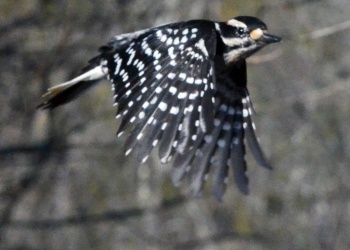m (typo in caption) |
(Flight picture. Extra subspecies added. References updated) |
||
| Line 19: | Line 19: | ||
====Subspecies==== | ====Subspecies==== | ||
[[Image:Harywpeck 25072009 post.jpg|thumb|350px|right|Juvenile<br />Photo by {{user|digishooter|digishooter}}<br />Wofford Heights, Kern Co., [[California]], [[USA]], July 2009]] | [[Image:Harywpeck 25072009 post.jpg|thumb|350px|right|Juvenile<br />Photo by {{user|digishooter|digishooter}}<br />Wofford Heights, Kern Co., [[California]], [[USA]], July 2009]] | ||
| − | There are | + | There are 15 subspecies<sup>[[#References|[1]]]</sup>: |
*''P. v. septentrionalis'': Western [[North America]] ([[Alaska]] to northern [[New Mexico]]) | *''P. v. septentrionalis'': Western [[North America]] ([[Alaska]] to northern [[New Mexico]]) | ||
*''P. v. villosus'': Eastern [[North Dakoka]] to southern [[Quebec]], [[Nova Scotia]], central [[Texas]], [[Missouri]], [[Virginia]] | *''P. v. villosus'': Eastern [[North Dakoka]] to southern [[Quebec]], [[Nova Scotia]], central [[Texas]], [[Missouri]], [[Virginia]] | ||
| Line 34: | Line 34: | ||
*''P. v. piger'': Northern [[Bahamas]] (Abaco, Mores and Grand Bahama) | *''P. v. piger'': Northern [[Bahamas]] (Abaco, Mores and Grand Bahama) | ||
*''P. v. maynardi'': Southern Bahamas (Andros and New Providence) | *''P. v. maynardi'': Southern Bahamas (Andros and New Providence) | ||
| + | *''P. v. extimus'': [[Costa Rica]] and western [[Panama]] | ||
| + | |||
==Habitat== | ==Habitat== | ||
| + | [[Image:Hairywpp.jpg|thumb|350px|right|Photo by {{user|Deerbird|Deerbird}}<br />[[Kentucky]], [[USA]], January 2016]] | ||
Woodlands and suburbs | Woodlands and suburbs | ||
==Behaviour== | ==Behaviour== | ||
| Line 44: | Line 47: | ||
Descending rattle: ''kekekekekekeke...'' A bit lower than Downy Woodpecker (but very similar). | Descending rattle: ''kekekekekekeke...'' A bit lower than Downy Woodpecker (but very similar). | ||
==References== | ==References== | ||
| − | #{{Ref- | + | #{{Ref-Clements6thAug15}} |
{{ref}} | {{ref}} | ||
==External Links== | ==External Links== | ||
Revision as of 23:47, 17 January 2016

Photo by Marcel Gauthier
Saint-Jean-sur-Richelieu, Quebec, Canada
- Picoides villosus
Identification
Males have a red patch on the back of the head.
Females lack this red patch.
Juvenile and second year birds have red feathers in the crown.
The male usually has a more extensive covering of red feathers than the female.
Variation
White on especially underparts can be replaced by buffy and the white on the back have reduced size in darker forms especially found in Pacific North-West and in Central America
Similar Species
Downy Woodpecker: Hairy Woodpecker has a proportionately larger bill that is about the same length as the head.

Photo by digishooter
Wofford Heights, Kern Co., California, USA, November 2009
Downy Woodpecker has a much smaller, stubbier bill. Hairy Woodpecker lacks dark markings on its outer tail feathers that the Downy has. (This field mark is less useful in the Northwest where darker races of both species exist and these marks are usually present)
Distribution
Nearly universal in North America. In the east north to southern Canada, in the west north to southern Alaska.
Also found in the mountains of Mexico and Central America south to Panama.
Taxonomy
Subspecies
There are 15 subspecies[1]:
- P. v. septentrionalis: Western North America (Alaska to northern New Mexico)
- P. v. villosus: Eastern North Dakoka to southern Quebec, Nova Scotia, central Texas, Missouri, Virginia
- P. v. terraenovae: Newfoundland
- P. v. sitkensis: Coastal south-eastern Alaska and northern British Columbia
- P. v. picoideus: Queen Charlotte Islands (off British Columbia)
- P. v. harrisi: Coastal southern British Columbia to north-western California
- P. v. audubonii: Southern Illinois to south-eastern Virginia, eastern Texas and Gulf Coast
- P. v. hyloscopus: Western California to northern Baja California
- P. v. orius: Cascade Mountains of British Columbia to south-eastern California and western Texas
- P. v. icastus: South-eastern Arizona and New Mexico through western Mexico to Jalisco
- P. v. jardinii: Central and eastern Mexico to Jalisco, Guerrero and Oaxaca
- P. v. sanctorum: Southern Mexico (Chiapas) and Guatemala to western Panama
- P. v. piger: Northern Bahamas (Abaco, Mores and Grand Bahama)
- P. v. maynardi: Southern Bahamas (Andros and New Providence)
- P. v. extimus: Costa Rica and western Panama
Habitat
Woodlands and suburbs
Behaviour
Diet
Diet includes insects, berries and acorns. Will also visit bird feeders for peanuts, suet, black oil sunflower seeds .
Breeding
Both sexes excavate a cavity in live wood. The clutch of 3 to 6 eggs are incubated by both adults. Males brood the eggs at night, and females during the day. Eggs hatch in about 14 days, and young birds leave the cavity in about a month. Young birds will accompany adults for the first two weeks or so before they become independent.
Vocalisation
Descending rattle: kekekekekekeke... A bit lower than Downy Woodpecker (but very similar).
References
- Clements, J. F., T. S. Schulenberg, M. J. Iliff, D. Roberson, T. A. Fredericks, B. L. Sullivan, and C. L. Wood. 2015. The eBird/Clements checklist of birds of the world: v2015, with updates to August 2015. Downloaded from http://www.birds.cornell.edu/clementschecklist/download/
Recommended Citation
- BirdForum Opus contributors. (2024) Hairy Woodpecker. In: BirdForum, the forum for wild birds and birding. Retrieved 21 May 2024 from https://www.birdforum.net/opus/Hairy_Woodpecker
External Links





